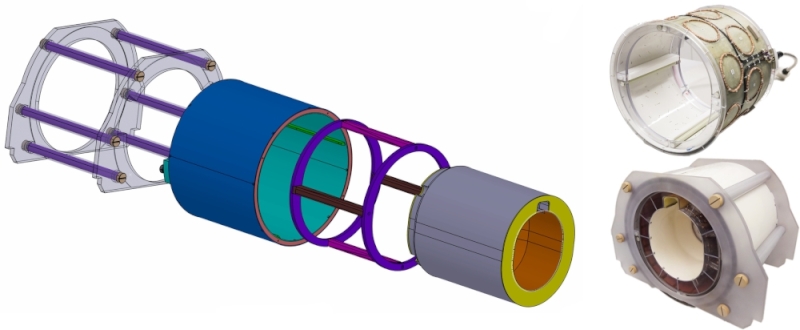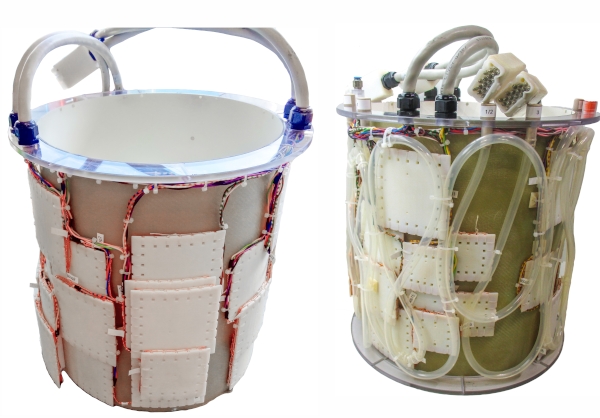Main Focus
Human brain shimming at 9.4T with a multi-coil setup
The homogeneity of the main static magnetic field (B0) is a crucial prerequisite for MR imaging due to the manifold image artifacts that can arise from field perturbations. B0 inhomogeneity becomes more pronounced with increasing field strength and can lead to severe image distortions. Usually, the scanners inbuilt shim system, which creates spherical harmonic (SH) field terms, is used for global static shimming. Recently, smaller local coils were proposed in the literature to achieve a higher shim performance. We have made a multi-coil setup to achieve a superior homogeneity of the B0 field.
16-Channel Multi-Coil
A multi-coil shim setup was constructed consisting of 16 circular coils, which were arranged in two rows. Each coil had 25 wire turns and a diameter of 100 mm. The coils were mounted on a fiber-glass cylinder having a diameter of 370 mm and a length of 310 mm. A custom-built amplifier was used to drive the 16 coils individually. Performance of the multi-coil setup was evaluated in terms of global and slice-wise dynamic shimming.

32-channel Optimized Multi-Coil
A multi-coil shim setup is designed and optimized for human brain shimming. The proposed design allows improving the shim performance without increasing the number of local shim coils. The optimized multi-coil performs better by 14.7% and 40% in comparison to the conventional symmetric design and scanner’s shim setup, respectively. The shimming performance is comparable with a full 5th order spherical harmonic shim coils.

Software tools
SpinWalk
SpinWalk is simulation famework, aims to simulate the behaviour of spins under a certain MR sequence in a microvascular network. The program tries to perform a Monte-Carlo simulation over range of spins which are randomly distributed and move in presence of user defined magnetic field. It is programmed in C++ and benefits CUDA to run in GPU.
Project homepage: https://github.com/aghaeifar/spinwalk
Abstract: https://www.ismrm.org/workshops/2023/BrainFunction/posters.htm
TurboBloch
Bloch Equation Simulator programmed in C++ and parallelized over spins. The program accept B1+ sensitivity map, allowing for parallel transmission (pTx) simulations. MATLAB and Python interface are provided.
Project homepage: https://github.com/aghaeifar/TurboBloch
AMoCo
Image quality in MRI is highly sensitive to the subject motion, and undesired motions lead to artifacts in final image. AMoCo (Adavanced MOtion COrrection) is a library for prospective motion correction that can be integrated into sequence and update RF and gradient based on the motion information received from a tracker (e.g., optical camera, field-probes, navigator). AMoCo is able to read from multiple tracking source and switch between tracker during runtime.
Abstract: https://www.ismrm.org/17/program_files/O63.htm
Related Paper: https://onlinelibrary.wiley.com/doi/10.1002/mrm.27343
.
Curriculum Vitae
| Since 06.2022 |
Postdoctoral researcher Max Planck Institute for Biological Cybernetics, Tübingen, Germany |
| 2020-2022 |
Honorary Research Fellow University College London (UCL), London, United Kingdom |
| 2020-2022 |
7T MRI Research Scientist Siemens Healthineers, London, United Kingdom |
2015-2019 |
Ph.D. in Neuroscience Max Planck Institute for Biological Cybernetics, Tübingen, Germany Graduate School of Neuroscience (Neural and Behavioral Science), University of Tübingen, Tübingen, Germany |
2010 - 2012 |
M.Sc. in Electrical Engineering, Iran University of Science & Technology, Tehran, Iran |
2006 - 2010 |
B.Sc. in Biomedical Engineering, AmirKabir University of Technology (Tehran Polytechnic), Tehran, Iran |